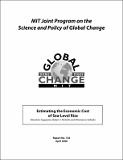Estimating the Economic Cost of Sea-Level Rise
Author(s)
Sugiyama, Masahiro.; Nicholls, Robert J.; Vafeidis, Athanasios
DownloadMITJPSPGC_Rpt156.pdf (807.6Kb)
Metadata
Show full item recordAbstract
To improve the estimate of economic costs of future sea-level rise associated with global climate change,
this report generalizes the sea-level rise cost function originally proposed by Fankhauser, and applies it
to a new database on coastal vulnerability developed as part of the Dynamic Interactive Vulnerability
Assessment (DIVA) tool.
An analytic expression for the generalized sea-level rise cost function is obtained to explore the effect of
various spatial distributions of capital and nonlinear sea-level rise scenarios. With its high spatial
resolution, the DIVA database shows that capital is usually highly spatially concentrated along a nation’s
coastline, and that previous studies, which assumed linear marginal capital loss for lack of this
information, probably overestimated the fraction of a nation’s coastline to be protected and hence
protection cost. In addition, the new function can treat a sea-level rise scenario that is nonlinear in time.
As a nonlinear sea-level rise scenario causes more costs in the future than an equivalent linear sea-level
rise scenario, using the new equation with a nonlinear scenario also reduces the estimated damage and
protection fraction through discounting of the costs in later periods.
Numerical calculations are performed, applying the cost function to the DIVA database and socioeconomic
scenarios from the MIT Emissions Prediction and Policy Analysis (EPPA) model. The effect of
capital concentration substantially decreases protection cost and capital loss compared with previous
studies, but not wetland loss. The use of a nonlinear sea-level rise scenario further reduces the total cost
because the cost is postponed into the future.
Description
Abstract in HTML and technical report in PDF available on the MIT Joint Program on the Science and Policy of Global Change website (http://mit.edu/globalchange/www/).
Date issued
2008-04Publisher
MIT Joint Program on the Science and Policy of Global Change
Citation
Report no. 156
Series/Report no.
Report no. 156